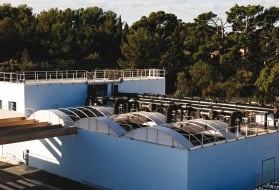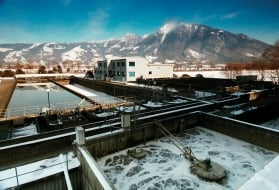special case of municipal WW disinfection
Reading time:Wastewater disinfection is becoming increasingly necessary, especially in the following cases:
- discharging into public swimming areas (river, lake or sea);
- discharging into oyster and shellfish farming areas (sea);
- systematic discharge standard, as exists for instance, in many American states;
- preliminary step for a number of re-use applications (at least all those where individuals may come into contact with the re-used water: physical contact, misting, fruit or vegetable washing, etc.), to be initiated as an “industrial” water source at the wastewater treatment plant itself.
Section oxidation and reduction and especially oxidation-disinfection provide the fundamentals as well as the performance expected of the various chemical disinfectants that can be used: Cℓ2 and derivatives (CℓO–, CℓO2, chloramines), ozone and peracetic acid as well as UV irradiation which has become a principle tool for disinfection of the present day given its reasonable cost and the absence of any disinfection by-products.
selecting and sizing a disinfection system
The selection of a target dose whether for irradiation or for chemical disinfection products primarily depends on:
- the target disinfection level expressed either as log removal (2 to 6 log) or as the absolute value of target residual contamination (e.g. < 10 EC for 100 mL);
- the pre-treatment undergone by the water and which establishes its residual contamination:
- by pathogenic micro-organisms;
- by suspended solids, organic matter that will affect the disinfectant’s effectiveness by:
- protecting micro-organisms (suspended solids);
- absorbing UV radiation (colour, suspended solids, organic matter, Fe3+, chelated Fe etc.) thus measuring transmittance (whether or not after filtration);
- reacting with oxidants: any reducing agent (organic matter but also S2–, NH4+, Fe2+…) will compete with micro organisms and, in order to achieve a given result, an overdose of disinfection agent will be needed.
Table 6 provides typical total coliform and fecal coliform levels at the inlet to the disinfection system depending on the pre-treatment line used.

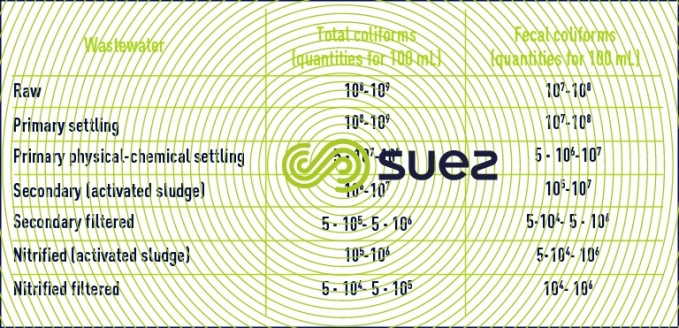

Consequently, when sizing a disinfection system, this presupposes a good knowledge or at the very least a sound assessment of all these parameters. Failing that, table 7 provides the values normally obtained.

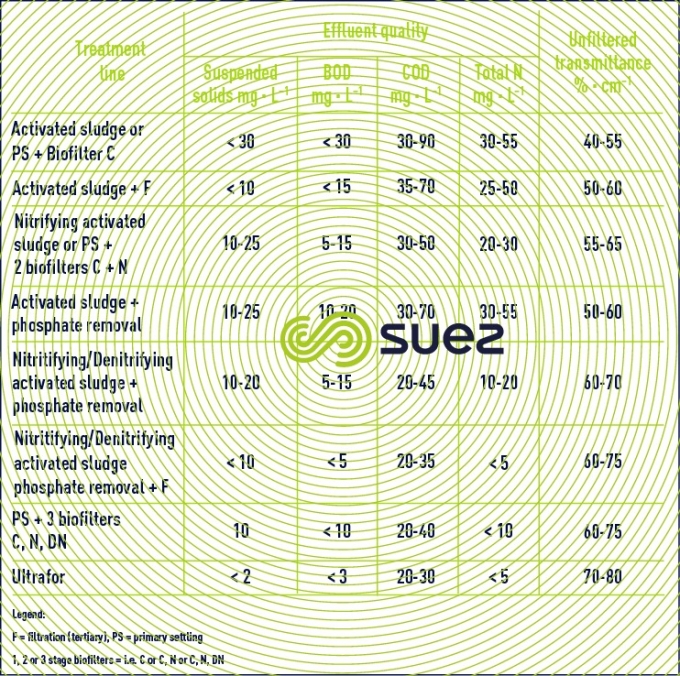

The following two simplified diagrams (figures 1 and 2) summarise the logical approach to reaching a decision on appropriate disinfection; these diagrams highlight the major questions that need to be asked about primary or secondary quality water.
Note: in the case of "tertiary" quality (figure 2), the quality will be that applicable to filtered water. All values are expressed as E. coli (EC) or fecal coliforms (FC). It should be noted that clarification and filtration treatments alone are effective against helminth eggs (table 9).

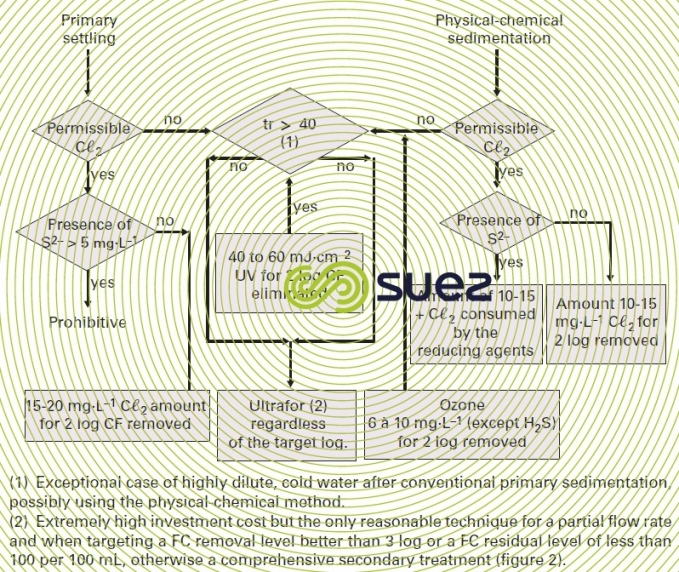


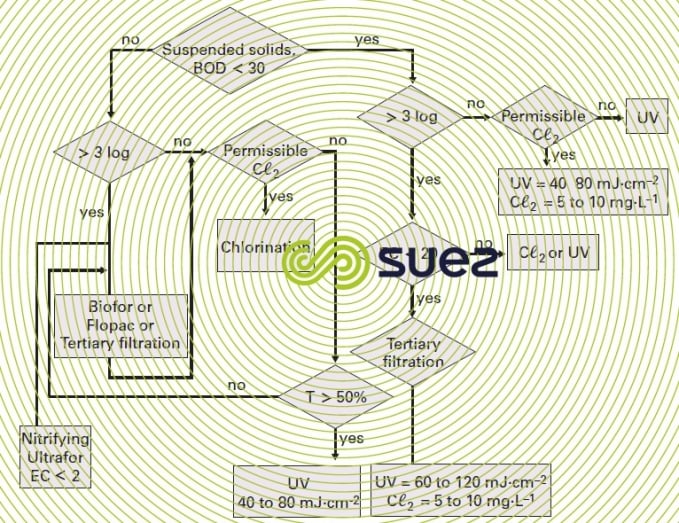

notes on bacteriological counts
Although bacteriological counts are far simpler than virus or protozoan cyst counts, they are nevertheless subject to a number of biases, the main one of which is sampling (see sampling). Additionally, many bacteria will fluctuate naturally with the hydraulic conditions prevailing in the mains sewer systems and these fluctuations will be present at both the disinfection inlet and at its outlet. Therefore, in order to properly establish the situation and to check disinfection effectiveness levels, the only valid method is the statistical approach. And then, the statistics have to be properly interpreted.
Table 8 shows how, based on two series of fecal and total coliform measurements carried out over 4 months (70 results) in a WWTP plant before and after UV disinfection, depending on the way the results are applied, discrepancies of almost 1 to 10 (see geometric mean and 95%ile) may result. All methods coexist and are justifiable depending on the greater or lesser reliability required of this disinfection. Again, it is important to accurately specify the project scope because system sizing and disinfection performance will depend directly on this.

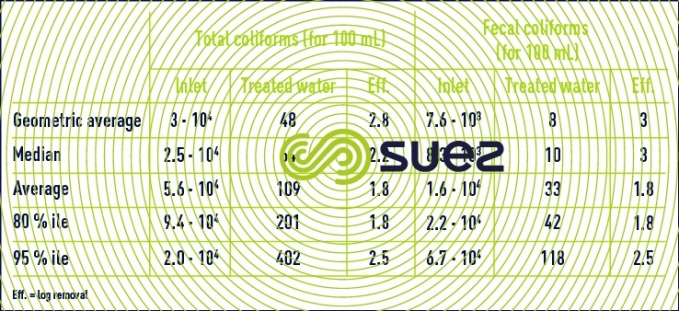

special case of helminth eggs
These eggs (see principles governing the classification of living beings table 5 and pathogenic micro-organisms) are particularly well protected and, therefore, as a rough guide, not affected by the different disinfectants (chemical or UV) at the dosages recommended for other pathogenic microorganisms; but the WHO recommends that they be eliminated down to less than 1 egg per litre in all water used for agricultural purposes.
They are removed by being physically trapped during the various treatment stages in a biological or physical-chemical line and often, when there is major raw water contamination, a tertiary filtration stage will be required in order to ensure that, more than 95% of the time, the requirements of the WHO standard are met (as shown in table 9).

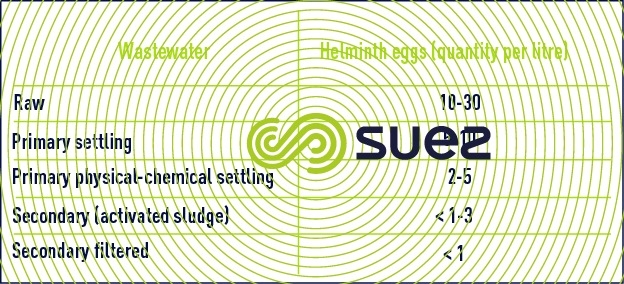

Bookmark tool
Click on the bookmark tool, highlight the last read paragraph to continue your reading later













